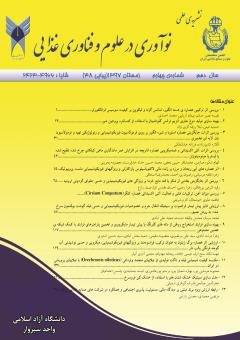مدلسازی سینتیک خشک شدن هلو با استفاده از خشککن فروسرخ
محورهای موضوعی : اصول مهندسی صنایع غذایی-مدل سازی
فخرالدین صالحی
1
![]() ,
اشرف گوهری اردبیلی
2
,
اشرف گوهری اردبیلی
2
1 - استادیار گروه علوم و صنایع غذایی، دانشگاه بوعلی سینا، همدان، ایران.
2 - استادیار گروه علوم و صنایع غذایی، دانشگاه بوعلی سینا، همدان، ایران.
کلید واژه: پرتودهی, مدلسازی, ضریب نفوذ مؤثر, هلو,
چکیده مقاله :
هلوی تازه از بیش از 86 درصد آب تشکیلشده است و جزء غنیترین منابع ویتامینها و مواد معدنی است. بنابراین میبایست آن را در طول سال بهصورت تازه یا خشک مصرف نمود. در این پژوهش مدلسازی سینتیک خشک شدن هلو در یک خشککن فروسرخ بررسی شد. تأثیر توان لامپ پرتودهی در سه سطح 150، 250 و 375 وات و فاصله نمونه از لامپ در سه سطح 5، 5/7 و 10 سانتیمتر بر زمان خشک شدن و ضریب نفوذ رطوبت در طی فرآیند خشک شدن هلو بررسی شد. مدلهای استاندارد (ونگ و سینگ، هندسون و پابیس، تقریب انتشار، پیج، پیج اصلاحشده، نیوتن، میدیلی و لگاریتمی) جهت بررسی سینتیک خشک شدن بر دادههای آزمایشی برازش داده شد و کیفیت برازش آنها مورد تجزیه و تحلیل قرار گرفت. نتایج نشانداد تأثیر توان لامپ پرتودهی و فاصله بر فرآیند خشک شدن هلو معنیدار میباشد. با افزایش توان لامپ فروسرخ از 150 به 375 وات زمان خشک شدن هلو 9/67 درصد کاهش یافت. کاهش فاصله لامپ از سطح نمونه از 10 به 5 سانتیمتر باعث کاهش 6/35 درصدی در زمان خشککردن شد. اثر توان حرارتی فروسرخ و فاصله نمونه از لامپ بر تغییرات ضریب نفوذ مؤثر هلو بررسی و نشانداد که با افزایش توان منبع حرارتی و کاهش فاصله مقدار ضریب نفوذ مؤثر افزایش مییابد. ضریب نفوذ مؤثر رطوبت هلو بین 9-10×42/1 تا 9-10×83/6 مترمربع بر ثانیه بود. در مدلسازی فرآیند خشککردن هلو مدل لگاریتمی نسبت به سایر مدلها با بزرگترین مقدار ضریب تعیین (R2) و کوچکترین خطا، نتایج نزدیکتری به دادههای آزمایش را داشت.
1. Kingsly, R. P., Goyal, R. K., Manikantan, M. R., Ilyas, S. M. 2007. Effects of pretreatments and drying air temperature on drying behaviour of peach slice, International Journal of Food Science & Technology, 42, 65-69.
2. Salehi, F., Abbasi Shahkoh, Z., Godarzi, M. 2015. Apricot Osmotic Drying Modeling Using Genetic Algorithm - Artificial Neural Network, Journal of Innovation in Food Science and Technology, 7, 65-76.
3. Rastogi, N. K. 2012. Recent trends and developments in infrared heating in food processing, Critical Reviews in Food Science and Nutrition, 52, 737-760.
4. Salehi, F., Kashaninejad, M., Asadi, F., Najafi, A. 2016. Improvement of quality attributes of sponge cake using infrared dried button mushroom, Journal of food science and technology, 53, 1418-1423.
5. Souti Khiabani, M., Sahari, M., Emam-Djomeh, Z. 2003. Improving the dehydration of dried peach by applying osmotic method, Iranian Journal of Agricultural Science, 34, 283-291.
6. Sahari, M., Souti, M., Emam-Jomeh, Z. 2006. Improving the dehydration of dried peach by osmotic method, Journal of Food Technology, 4, 189-193.
7. Germer, S. P. M., Queiroz, M. R., Aguirre, J. M., Berbari, S. A. G., Anjos, V. D. 2010. Process variables in the osmotic dehydration of sliced peaches, Food Science and Technology (Campinas), 30, 940-948.
8. Salehi, F., Kashaninejad, M., Akbari, E., Sobhani, S. M., Asadi, F. 2016. Potential of Sponge Cake Making using Infrared–Hot Air Dried Carrot, Journal of texture studies, 47, 34-39.
9. Doymaz, I. 2011. Drying of eggplant slices in thin layers at different air temperatures, Journal of Food Processing and Preservation, 35, 280-289.
10. Doymaz, I. 2009. Mathematical modelling of thin‐layer drying of kiwifruit slices, Journal of Food Processing and Preservation, 33, 145-160.
11. Toğrul, H. 2006. Suitable drying model for infrared drying of carrot, Journal of Food Engineering, 77, 610-619.
12. Toğrul, İ. T., Pehlivan, D. 2004. Modelling of thin layer drying kinetics of some fruits under open-air sun drying process, Journal of Food Engineering, 65, 413-425.
13. Yazdani, M., Borghaee, A. M., Rafiee, S., Minaei, S., Beheshti, B. 2013. Mathematical and neural networks modeling of thin-layer drying of peach (Prunus persica) slices and their comparison, European Journal of Experimental Biology, 3, 712-721.
14. Salehi, F., Kashaninejad, M., Jafarianlari, A. 2017. Drying kinetics and characteristics of combined infrared-vacuum drying of button mushroom slices, Heat and Mass Transfer, 53, 1751-1759.
15. Doymaz, I. 2007. The kinetics of forced convective air-drying of pumpkin slices, Journal of Food Engineering, 79, 243-248.
16. Wong, J. Y. 2001. Theory of ground vehicles, John Wiley & Sons,
17. Jain, D., Pathare, P. B. 2004. Selection and evaluation of thin layer drying models for infrared radiative and convective drying of onion slices, Biosystems Engineering, 89, 289-296.
18. Ratti, C., Mujumdar, A. 1995. Infrared drying, Handbook of Industrial Drying, Ed. Mujumdar, A. S., Second edition, New York, NY, Marcel Dekker Inc., 1, 567-588.
19. Gorjian, S. Modelling of thin layer drying kinetics of barberry fruit. Faculty of Agriculture. Tarbiat Modares University, Tehran, Iran. in, Farsi, 2009.
20. Doymaz, I., Pala, M. 2003. The thin-layer drying characteristics of corn, Journal of Food Engineering, 60, 125-130.
21. Wang, Z., Sun, J., Liao, X., Chen, F., Zhao, G., Wu, J., Hu, X. 2007. Mathematical modeling on hot air drying of thin layer apple pomace, Food Research International, 40, 39-46.
22. Golisz, E., Jaros, M., Kalicka, M. 2013. Analysis of convectional drying process of peach, Technical Sciences/University of Warmia and Mazury in Olsztyn.
23. Jaya, S., Das, H. 2003. A vacuum drying model for mango pulp, Drying Technology, 21, 1215-1234.
24. Mitra, J., Shrivastava, S., Rao, P. S. 2011. Vacuum dehydration kinetics of onion slices, Food and Bioproducts Processing, 89, 1-9.
25. Omid, M., Yadollahinia, A., Rafiee, S. A thin-layer drying model for paddy dryer. in: Proc. of the International conference on Innovations in Food and Bioprocess Technologies, AIT, Pathumthani, Thailand, 12th, 2006, pp. 202-211.


